new posts in all blogs
Viewing: Blog Posts Tagged with: 2016 imports, Most Recent at Top [Help]
Results 1 - 5 of 5
How to use this Page
You are viewing the most recent posts tagged with the words: 2016 imports in the JacketFlap blog reader. What is a tag? Think of a tag as a keyword or category label. Tags can both help you find posts on JacketFlap.com as well as provide an easy way for you to "remember" and classify posts for later recall. Try adding a tag yourself by clicking "Add a tag" below a post's header. Scroll down through the list of Recent Posts in the left column and click on a post title that sounds interesting. You can view all posts from a specific blog by clicking the Blog name in the right column, or you can click a 'More Posts from this Blog' link in any individual post.

By:
Betsy Bird,
on 12/11/2016
Blog:
A Fuse #8 Production
(
Login to Add to MyJacketFlap)
JacketFlap tags:
Best Books,
translations,
children's literature in translation,
translated picture books,
imports,
Best Books of 2016,
2016 imports,
2016 translated children's books,
31 days 31 lists,
Add a tag
 I know it gets confusing but this list is a bit different from the Calde-not list from a couple days ago. The reason is simple. While the Calde-not list looks primarily at books with illustrations so distinguished they could easily win major illustration awards if given half a chance, this is list is more for those books that may not blow you away on a first glance, but that make our publishing landscape richer for their very existence. I was inordinately pleased after I read each and every one of these books. They’re a little peculiar, distinctly different from what you’ll find in the American market, and altogether remarkable.
I know it gets confusing but this list is a bit different from the Calde-not list from a couple days ago. The reason is simple. While the Calde-not list looks primarily at books with illustrations so distinguished they could easily win major illustration awards if given half a chance, this is list is more for those books that may not blow you away on a first glance, but that make our publishing landscape richer for their very existence. I was inordinately pleased after I read each and every one of these books. They’re a little peculiar, distinctly different from what you’ll find in the American market, and altogether remarkable.
2016 International Imports for Kids
Picture Books
Chirri & Chirra by Yuki Kaneko

Sweet and dreamlike, this Japanese import has a light and sweetness to it that will simultaneously make it deeply beloved in a few select homes, while also not drawing so much attention to itself that it ever becomes much more than a cult hit in the States. Do yourself a favor and discover it. It’s the kind of book you want to influence the dreams of your children with.
Cry, Heart, But Never Break by Glenn Ringtved, ill. By Charlotte Pardi
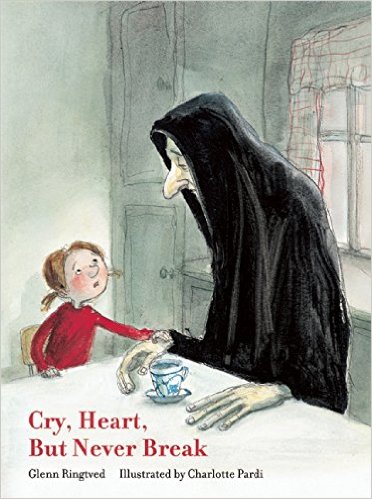
This Danish import just reminds us that when it comes to poetic picture books about death, American just don’t deal very well. Our death books tend to either be straightforward guides (here’s what to expect, etc.) or complete and utter fanciful metaphors. This book feels like it’s both fable and straightforward talk. A rare thing.
The Day I Became a Bird by Ingrid Chabbert, ill. Guridi

Kirkus didn’t get it. SLJ did. In this story a boy falls in love with a bird-loving girl. To get her attention he constructs an elaborate bird costume. Make of that what you will.
Don’t Cross the Line! by Bernardo P. Caravalho, ill. Isavel Martins

Portugal! And an interesting book at that. This one combines the interactive qualities of something like Don’t Let the Pigeon Drive the Bus or Press Here with a political statement about thwarting unjust authority. This book may get a bit more play in the coming years.
Look Up by Jung Jin-Ho

I love this one since it confronts and rearranges the reading experience and expectations of children. Add in the fact that it stars a girl in a wheelchair (who is not solely defined as a person from that chair) and you’ve got a golden book on your hands.
My Baby Crocodile by Gaetan Doremus
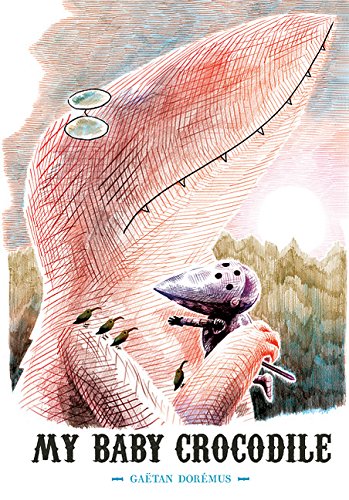
Funny story. I cannot read this book without setting it to the tune of “My Funny Valentine”. I suspect that this is because the two phrases share the same number of syllables more than anything else, but maybe it also has to do with the strange nature of love celebrated in this book. The story is between a near-sighted crocodile that “adopts” a knight, thinking he’s a baby croc. It’s odd and sweet and strange and funny. Memorable too.
A Promise Is a Promise by Knister, ill. Eve Tharlet

I found this one interesting perhaps because of the deep-seated feeling of betrayal our hero suffers in the course of things. It’s a very childlike understanding of an impossible promise and I like how it’s handled. A book that belies its cutesy cover.
Undercover by Bastien Contraire
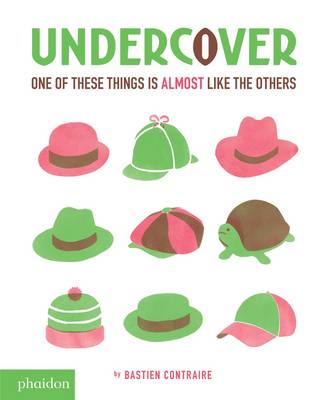
I absolutely adore this book. It’s a story where you have to spot the thing that doesn’t match. Contraire, living up to his name, doesn’t make it easy on you, though. The cover alone should be enough to prove that to you.
What Color Is the Wind? By Anne Herbauts
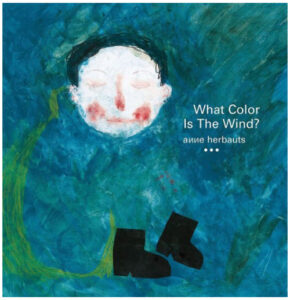
I’ve already reviewed it but if you somehow missed mention of this marvelous books about blindness and tactile response, now’s the time. You won’t find anything else like it on the market today.
Why Am I Here? by Constance Orbeck-Nilssen, ill. Akin Duzakin

Big questions for little brains. I like this one a lot. Lemur or not lemur.
Middle Grade
The Birth of Kitaro by Shigeru Mizuki

Honestly the backmatter explaining the entire history of the yokai in Japanese history and literature is some of the most fascinating stuff here. In a way, this book reads like what would have happened if Quasimodo turned into a superhero rather than a bell fantastic. I loved the peculiar (to me) nature of the storylines, the characters, and particularly the creatures.
The Heartless Troll by Oyvind Torseter
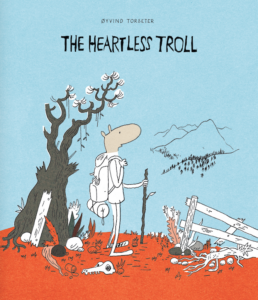
The troll is, without a doubt, one of the most horrific renderings I’ve seen in a children’s book in a long time. Which is to say – it’s awesome! Definitely hand this to older kids, but appreciate it on your own when you get a chance. As graphic novels go, there are few things to compare it to.
Under Earth / Under Water by Aleksandra Mizielinska and Daniel Mizielinski
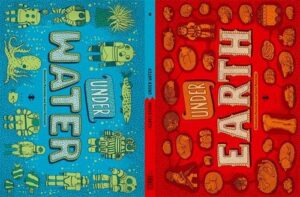
This Polish import is fantastic. There was a book of maps that came out from this couple previously. I’m not as big a fan of those, but what I am a fan of is learning about all that goes on below. Good times.
Misc
And just a quick shout-out to the Candied Plums titles that aren’t online yet. These are the real deal. I just adore them:
- Little Rabbit’s Questions by Dayong Gan, translated by Helen Wang (978194529270 – www.candiedplums.com)
- Picking Turnips by Xu Zhou, translated by Adam Lanphier (9781945295263 – www.candiedplums.com)
- Who Wants Candied Hawberries? by Dongni Bao, ill. Di Wu, translated by Adam Lanphier
Interested in the other lists of the month? Here’s the schedule so that you can keep checking back:
December 1 – Board Books
December 2 – Board Book Adaptations
December 3 – Nursery Rhymes
December 4 – Picture Book Readalouds
December 5 – Rhyming Picture Books
December 6 – Alphabet Books
December 7 – Funny Picture Books
December 8 – Calde-Nots
December 9 – Picture Book Reprints
December 10 – Math Picture Books
December 11 – Bilingual Books
December 12 – International Imports
December 13 – Books with a Message
December 14 – Fabulous Photography
December 15 – Fairy Tales / Folktales
December 16 – Oddest Books of the Year
December 17 – Older Picture Books
December 18 – Easy Books
December 19 – Early Chapter Books
December 20 – Graphic Novels
December 21 – Poetry
December 22 – Fictionalized Nonfiction
December 23 – American History
December 24 – Science & Nature Books
December 25 – Transcendent Holiday Titles
December 26 – Unique Biographies
December 27 – Nonfiction Picture Books
December 28 – Nonfiction Chapter Books
December 29 – Novel Reprints
December 30 – Novels
December 31 – Picture Books


By:
Betsy Bird,
on 11/13/2016
Blog:
A Fuse #8 Production
(
Login to Add to MyJacketFlap)
JacketFlap tags:
middle grade historical fantasy,
Kate Saunders,
Best Books of 2016,
2016 imports,
2016 reviews,
Reviews 2016,
2016 middle grade fantasy,
2016 middle grade historical fiction,
Reviews,
middle grade fantasy,
Random House,
Best Books,
Delacorte Press,
WWI,
middle grade historical fiction,
Add a tag
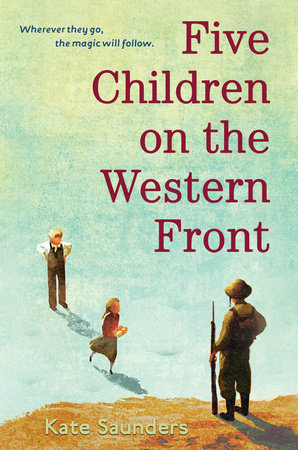 Five Children on the Western Front
Five Children on the Western Front
By Kate Saunders
Delacorte Press (an imprint of Random House)
$16.99
ISBN: 978-0-553-49793-9
Ages 9-12
On shelves now
Anytime someone writes a new prequel or sequel to an old children’s literary classic, the first question you have to ask is, “Was this necessary?” And nine times out of ten, the answer is a resounding no. No, we need no further adventures in the 100-Acre Woods. No, there’s very little reason to speculate on precisely what happened to Anne before she got to Green Gables. But once in a while an author gets it right. If they’re good they’ll offer food for thought, as when Jacqueline Kelly wrote, Return to the Willows (the sequel to The Wind in the Willows) and Geraldine McCaughrean wrote Peter Pan in Scarlet. And if they’re particularly talented, then they’ll do the series one better. They’ll go and make it smart and pertinent and real and wonderful. They may even improve upon the original. The idea that someone would write a sequel to Five Children and It (and to a lesser extent The Phoenix and the Carpet and The Story of the Amulet) is well-nigh short of ridiculous. I mean, you could do it, sure, but why? What’s the point? Well, as author Kate Saunders says of Nesbit’s classic, “Bookish nerd that I was, it didn’t take me long to work out that two of E. Nesbit’s fictional boys were of exactly the right ages to end up being killed in the trenches…” The trenches of WWI, that is. Suddenly we’ve an author who dares to meld the light-hearted fantasy of Nesbit’s classic with the sheer gut-wrenching horror of The War to End All Wars. The crazy thing is, she not only pulls it off but she creates a great novel in the process. One that deserves to be shelved alongside Nesbit’s original for all time.
Once upon a time, five children found a Psammead, or sand fairy, in their back garden. Nine years later, he came back. A lot has happened since this magical, and incredibly grumpy, friend was in the children’s lives. The world stands poised on the brink of WWI. The older children (Cyril, Anthea, Robert, and Jane) have all become teenagers, while the younger kids (Lamb and newcomer Polly) are the perfect age to better get to know the old creature’s heart. As turns out, he has none, or very little to speak of. Long ago, in ancient times, he was worshipped as a god. Now the chickens have come home to roost and he must repent for his past sins or find himself stuck in a world without his magic anymore. And the children? No magic will save them from what’s about to come.
A sequel to a book published more than a hundred years ago is a bit more of a challenge than writing one published, say, fifty. The language is archaic, the ideas outdated, and then there’s the whole racism problem. But even worse is the fact that often you’ll find character development in classic titles isn’t what it is today. On the one hand that can be freeing. The author is allowed to read into someone else’s characters and present them with the necessary complexity they weren’t originally allowed. But it can hem you in as well. These aren’t really your characters, after all. Clever then of Ms. Saunders to age the Lamb and give him a younger sister. The older children are all adolescents or young adults and, by sheer necessity, dull by dint of age. Even so, Saunders does a good job of fleshing them out enough that you begin to get a little sick in the stomach wondering who will live and who will die.
This naturally begs the question of whether or not you would have to read Five Children and It to enjoy this book. I think I did read it a long time ago but all I could really recall was that there were a bunch of kids, the Psammead granted wishes, the book helped inspire the work of Edgar Eager, and the youngest child was called “The Lamb”. Saunders tries to play the book both ways then. She puts in enough details from the previous books in the series to gratify the Nesbit fans of the world (few though they might be) while also catching the reader up on everything that came before in a bright, brisk manner. You do read the book feeling like not knowing Five Children and It is a big gaping gap in your knowledge, but that feeling passes as you get deeper and deeper into the book.
One particular element that Ms. Saunders struggles with the most is the character of the Psammead. To take any magical creature from a 1902 classic and to give him hopes and fears and motivations above and beyond that of a mere literary device is a bit of a risk. As I’ve mentioned, I’ve not read “Five Children and It” in a number of years so I can’t recall if the Psammead was always a deposed god from ancient times or if that was entirely a product from the brain of Ms. Saunders. Interestingly, the author makes a very strong attempt at equating the atrocities of the Psammead’s past (which are always told in retrospect and are never seen firsthand) with the atrocities being committed as part of the war. For example, at one point the Psammead is taken to the future to speak at length with the deposed Kaiser, and the two find they have a lot in common. It is probably the sole element of the book that didn’t quite work for me then. Some of the Psammead’s past acts are quite horrific, and he seems pretty adamantly disinclined to indulge in any serious self-examination. Therefore his conversion at the end of the book didn’t feel quite earned. It’s foolish to wish a 250 page children’s novel to be longer, but I believe just one additional chapter or two could have gone a long way towards making the sand fairy’s change of heart more realistic. Or, at the very least, comprehensible.
When Ms. Saunders figured out the Cyril and Robert were bound for the trenches, she had a heavy task set before her. On the one hand, she was obligated to write with very much the same light-hearted tone of the original series. On the other hand, the looming shadow of WWI couldn’t be downplayed. The solution was to experience the war in much the same way as the characters. They joke about how short their time in the battle will be, and then as the book goes along the darkness creeps into everyday life. One of the best moments, however, comes right at the beginning. The children, young in the previous book, take a trip from 1905 to 1930, visit with their friend the professor, and return back to their current year. Anthea then makes an off-handed comment that when she looked at the photos on the wall she saw plenty of ladies who looked like young versions of their mother but she couldn’t find the boys. It simply says after that, “Far away in 1930, in his empty room, the old professor was crying.”
So do kids need to have read Five Children and It to enjoy this book? I don’t think so, honestly. Saunders recaps the originals pretty well, and I can’t help but have high hopes for the fact that it may even encourage some kids to seek out the originals. I do meet kids from time to time that are on the lookout for historical fantasies, and this certainly fits the bill. Ditto kids with an interest in WWI and (though this will be less common as the years go by) kids who love Downton Abbey. It would be remarkably good for them. Confronting issues of class, disillusion, meaningless war, and empathy, the book transcends its source material and is all the better for it. A beautiful little risk that paid off swimmingly in the end. Make an effort to seek it out.
On shelves now.
Source: Final copy sent from publisher for review.
Like This? Then Try:
Other Blog Reviews: educating alice
Professional Reviews:


By:
Betsy Bird,
on 10/11/2016
Blog:
A Fuse #8 Production
(
Login to Add to MyJacketFlap)
JacketFlap tags:
Reviews,
Best Books,
Anne Herbauts,
French children's books,
Enchanted Lion Books,
French picture books,
translated picture books,
international children's books,
Best Books of 2016,
2016 imports,
2016 picture books,
2016 reviews,
Reviews 2016,
2016 translated children's books,
Add a tag
 What Color Is the Wind?
What Color Is the Wind?
By Anne Herbauts
Translated by Claudia Zoe Bedrick
Enchanted Lion Books
$19.95
ISBN: 978-1-59270-221-3
Ages 5 and up
On shelves now
I’m going to have a hard time of it when my kids grow up. When I had them I swore up, down and sideways that I wouldn’t turn into the kind of blogger that declares that a book is good or bad, based solely on the whims of my impertinent offspring. For the most part, I’ve kept that promise. I review picture books outside of their influence, though I’m always interested in their opinions. Indeed, these opinions, and the sharp eyes that inform them, are sometimes not what I’d expect at all. So while I’ve never changed my opinion from liking a book to not liking it just because it didn’t suit my own particular kids’ tastes, I have admittedly found a new appreciation for other books when the children were able to spot things that I did not. What Color Is the Wind? is a pretty good example of this. I read the book at work, liked it fine, and brought it home for a possible review. My daughter then picked it up and proceeded to pretty much school me on what it contained, front to finish. Had I noticed the Braille on the cover? No. Did I see that the main character’s eyes are closed the whole time? No. How about the tactile pages? Did you notice that you can feel almost all of them? No. For a book that may look to some readers as too elegant and sophisticated to count as a favored bedtime story, think again. In this book Anne Herbauts proves beyond a shadow of a doubt that a distinct European style is engaging to American children when their parents give it half a chance. Particularly when tactile elements are involved.
 “We can’t see the wind, / we hear what it brings. / We can’t hear the wind, / we see what it brings.” The book begins with a question. A boy, his eyes closed, walks behind the cutout of a house. “What color is the wind? asks the little giant.” As he walks along, various plants, birds, animals, and inanimate objects offer answers. A wolf says the wind’s color is “the dark smell of the forest” while a window disagrees and says it’s “the color of time.” Everything that answers the little giant has a different feel on the page. The stream feels like consecutive ripples emanating from a dropped pebble, the roots of an apple tree like long, thin rivulets. At last the little giant encounters something that he senses is enormous. He asks his question and an enormous giant replies, “It is everything at once. This whole book.” He flips the book’s pages with his thumb so that they fly, and you the reader do the same, feeling the wind the book is capable of producing with its thick, lustrous pages. The color of the wind. The wind of this book.
“We can’t see the wind, / we hear what it brings. / We can’t hear the wind, / we see what it brings.” The book begins with a question. A boy, his eyes closed, walks behind the cutout of a house. “What color is the wind? asks the little giant.” As he walks along, various plants, birds, animals, and inanimate objects offer answers. A wolf says the wind’s color is “the dark smell of the forest” while a window disagrees and says it’s “the color of time.” Everything that answers the little giant has a different feel on the page. The stream feels like consecutive ripples emanating from a dropped pebble, the roots of an apple tree like long, thin rivulets. At last the little giant encounters something that he senses is enormous. He asks his question and an enormous giant replies, “It is everything at once. This whole book.” He flips the book’s pages with his thumb so that they fly, and you the reader do the same, feeling the wind the book is capable of producing with its thick, lustrous pages. The color of the wind. The wind of this book.
The Kirkus review journal said that this book was, “ ‘The blind men and the elephant’ reworked into a Zen koan” and then proceeded to recommend it for 9-11 year-olds and adults. I’m fairly certain I disagree with almost every part of that. Now here’s the funny part. I didn’t read this review before I read the book. I also didn’t read the press release that was sent to me with it. When I read a book I like to be surprised by it in some way. This is usually a good thing, but once in a while I can be a bit dense and miss the bigger picture. As I mentioned before, I completely missed the fact that this book was an answer to a blind child who had asked Anne Herbauts the titular question. I just thought it was cool that the book was so much fun to touch. Embossing, debossing, die-cuts, lamination, and all kinds of surfaces give the book the elements that make it really pop. As I read it in the lunchroom at work, my co-workers would peer over my shoulders to coo at what they saw. All well and good, but would a kid be interested too? Kirkus says they’d have to be at least nine to grasp its subtleties.
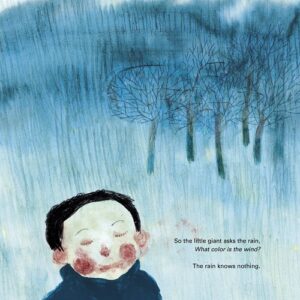 Obviously my 5-year-old daughter likes the book but she’s just one kid. She is not a representative for her species (so to speak). That said, this book just drills home the advantage that physical books have over their electronic counterparts: the sensation of touch. Play with a screen all day if you like, but you will never be able to move your fingers over these raised dots of rain or the rough bark of a tree’s trunk. As children become more immersed in the electronic, they become more enamored of tactile books. The sensation of paper on skin has yet to be replicated by our smooth as silk screens. And this will prove true with kids on the younger end of the scale. I’ll agree with Kirkus about the adult designation, though. When I worked for New York Public Library there was a group of special needs adults that would come in that were in need of tactile picture books. We would be asked if we had any on hand that we could hand over to them in some way. There were a few, but our holdings were pretty limited (though I do remember a particularly keen tactile version of The Very Hungry Caterpillar that proved to be a big hit). Those kids would have loved this book, but children of all ages, and all abilities, would feel the same way about it. Kids are never too old for tactile picture books. As such, you could use this book with Kindergartners as well as fifth graders. Little kids will like the fun pictures. Older kids may be inspired by the words as well.
Obviously my 5-year-old daughter likes the book but she’s just one kid. She is not a representative for her species (so to speak). That said, this book just drills home the advantage that physical books have over their electronic counterparts: the sensation of touch. Play with a screen all day if you like, but you will never be able to move your fingers over these raised dots of rain or the rough bark of a tree’s trunk. As children become more immersed in the electronic, they become more enamored of tactile books. The sensation of paper on skin has yet to be replicated by our smooth as silk screens. And this will prove true with kids on the younger end of the scale. I’ll agree with Kirkus about the adult designation, though. When I worked for New York Public Library there was a group of special needs adults that would come in that were in need of tactile picture books. We would be asked if we had any on hand that we could hand over to them in some way. There were a few, but our holdings were pretty limited (though I do remember a particularly keen tactile version of The Very Hungry Caterpillar that proved to be a big hit). Those kids would have loved this book, but children of all ages, and all abilities, would feel the same way about it. Kids are never too old for tactile picture books. As such, you could use this book with Kindergartners as well as fifth graders. Little kids will like the fun pictures. Older kids may be inspired by the words as well.
“Mom,” said my daughter as we went down the stairs for her post-reading, pre-brushing, nighttime snack. “Mom, you know the wind doesn’t have a color, right?” My child is a bit of a literalist. She’s the kid who knew early on that magic wasn’t real and once told me at the age of three that, “If ‘please’ is a magic word, it doesn’t exist.” So to read an entire book, based on the premise of seeing a color that couldn’t possibly be real, was a stretch for her. Remember, we read this entire book without really catching on that the little giant was blind. I countered that it was poetry, really. Colors were just as much about what they looked like as what they felt like. I asked her what blue made her feel, and red. Then I applied that to the emotions we feel about with the wind, which wasn’t really an analogy that held much water, but she was game to hear me out. “It’s poetry”, I said again. “Words that make you feel something when you read them.” So, as she had her snack, she had me read her some poetry. We’ve been reading poetry with her snack every night since. So for all that the book could be seen to be a straightforward picture book, to me it’s as much an introduction to poetry as anything else.
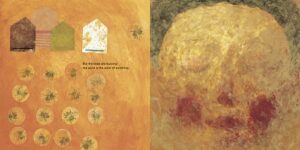
As for the art, I’ll admit that the combination of the style of art, the image on the cover, and the fact that the book is softcover and not hardcover (a cost-saving measure for what must be a very expensive title for Enchanted Lion Books to publish) did not immediately appeal to me. There’s no note to explain what the medium is and if I were to guess I’d say we were looking at crayons, mixed media, thick paints, colored pencils, ink blots, pen-and-inks, and more. Ironically, I really began to gravitate to the art when the little giant wasn’t stealing my focus. Nothing is intricately detailed, except perhaps the anatomy of honeybees or the raised and bumpy parts of the book. At the same time, for a book that celebrates touch, poetry, and physical sensation, the colors are often bright and lush. Whether it’s the blue watercolors of rain over trees or the hot orange that emanates from the page like a sun, Herbauts is simultaneously rendering illustrations obsolete with the unique format of What Color is the Wind? and celebrating their visual extremes.
I tend to give positive reviews to books that exceed my expectations. That’s just the nature of my occupation. And while I do believe that there are elements to this book that could be clearer or that there must have been a book jacket choice they could have chosen that was more appealing than the one you see here, otherwise I think this little book is a bit of a wonder. Deeply appealing to children of all ages, to say nothing of the adults out there, with so many uses, and so many applications. It reminds me of the old picture books by Bruno Munari that weren’t afraid to try new things with the picture book format. To get a little crazy. I don’t think we’ll suddenly see a big tactile picture book craze sweep the nation or anything, but maybe this book will inspire just one other publisher to try something a little different and to take a risk. Could be worth it. There’s nothing else like this book out there today. More’s the pity.
On shelves now.
Source: Final edition sent from publisher for review.
Like This? Then Try:
Professional Reviews:
Misc: A deeper look at some of the art over at Seven Impossible Things Before Breakfast


By:
Betsy Bird,
on 2/8/2016
Blog:
A Fuse #8 Production
(
Login to Add to MyJacketFlap)
JacketFlap tags:
Canadian children's books,
Chronicle,
early chapter books,
Patrick Doyon,
2016 imports,
2016 reviews,
Reviews 2016,
2016 early chapter books,
Andrew Marois,
Reviews,
Add a tag
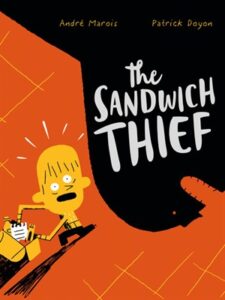 The Sandwich Thief
The Sandwich Thief
By Andre Marois
By Patrick Doyon
Chronicle Books
$14.99
ISBN: 978-1-4521-4659-1
Ages 7-9
On shelves March 1st
Injustice, that sweet universal quality, makes for great children’s books. Whether it’s a picture book or a young adult novel, if you can tap into a reader’s sense of unfairness you have yourself some children’s book gold. It’s the instantaneous gateway to identification. Adults too often forget how painful those early lessons about how the world is an unfair place feel. Children’s books tap into that feeling, while also giving kids a sense of hope. Yes, the world is a mad, bad place sometimes. But there are times when things work out for the best. And if its takes disgusting flavor balls in delicious sandwiches to reach that cathartic ending, so much the better. I wouldn’t argue that Andre Marois’s The Sandwich Thief is the greatest book on this subject I’ve ever seen (it could use a little work in the empathy department), but when it comes to tapping into that feeling of unbridled rage in the face of a cold, calculating world, this title definitely knows its audience.
There are upsides and downsides to having foodies for parents. On the one hand, they can seriously embarrass you when they overdo your school lunches. On the other hand, delicious sandwiches galore! Marin’s a big time fan of his mom’s sandwich constructions, particularly when graced with her homemade mayonnaise, but then one day the unthinkable occurs. Marin goes to take his sandwich to the lunchroom only to find it is gone! When it happens a second time on a second day Marin is convinced that a thief is in his midst. But who could it be? A classmate? A teacher? Everyone is suspect but it’s Marin’s clever mama who knows how to use her mad genius skills to out the culprit, and in a very public way!
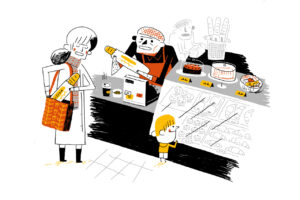 Writing a good early chapter book takes some daring. The form is so incredibly limited. It’s best to have a story that can be read in a single sitting by a parent, or over the course of several attempts by a child just getting used to longer sentences. In this book Marois sets up his mystery with care. There are lots of red herrings, but the author also plays fair, including the true villain amongst the innocuous innocents. The adults made for particularly interesting reading. For example, I loved the portrait of Marin’s principal Mr. Geiger, a man so rumpled and ill-fed you wonder for quite some time how he got his current position (he redeems himself at the end, though).
Writing a good early chapter book takes some daring. The form is so incredibly limited. It’s best to have a story that can be read in a single sitting by a parent, or over the course of several attempts by a child just getting used to longer sentences. In this book Marois sets up his mystery with care. There are lots of red herrings, but the author also plays fair, including the true villain amongst the innocuous innocents. The adults made for particularly interesting reading. For example, I loved the portrait of Marin’s principal Mr. Geiger, a man so rumpled and ill-fed you wonder for quite some time how he got his current position (he redeems himself at the end, though).
I like to tell folks that we are currently in a new Golden Age of children’s literature. This is, admittedly, a fairly ridiculous statement to make since few people can be aware of a Golden Age, even if they are already waist deep in it. Still, the evidence is striking. Never before have authors or illustrators had so much freedom to play around with forms, construction, colors, art styles, etc. It’s not a free-for-all or anything (unless you’re self-publishing) but ideas that publishers might have balked at twenty years ago are almost commonplace today. Take The Sandwich Thief as one such example. Here you have an early chapter book that draws heavily on the classic comic tradition. But speech balloons aside, artist Patrick Doyon makes every single page an eclectic experience. A French-Canadian editorial illustrator who had never made a children’s book prior to this one, in this book Doyon moves effortlessly between two-page spreads, borderless panels, sequential art, the works. You might be so wrapped up in the form that you’d miss how limited his palette is. Working entirely in orange, red, and black, Doyon’s talents are such that you never even notice the missing colors during your reading experience.
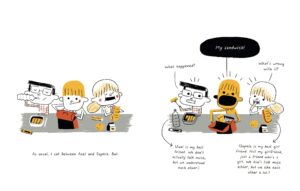 Sadly, there are some aspects to this brand new book that feel like they were written twenty or thirty years ago (and not in a good way). When identifying the potential thieves in his classroom, Marin falls back onto some pretty broad stereotypes. We’re in an era when body acceptance makes old-fashioned fat shaming feel downright archaic. With that in mind, the identification of one student as “Big Bobby” whose “main hobby is eating” is particularly unfortunate. Add in “Poor Marie” whose mom lost her job and can’t afford to eat, and you’ve got yourself an odd avoidance of sympathy. Another reader of this book mentioned that the villains is of a similar lower-socioeconomic level, which is questionable. There are also a couple insults like “Numbnuts” floating about the text that will pass without comment in some households and be a major source of contention in others. FYI.
Sadly, there are some aspects to this brand new book that feel like they were written twenty or thirty years ago (and not in a good way). When identifying the potential thieves in his classroom, Marin falls back onto some pretty broad stereotypes. We’re in an era when body acceptance makes old-fashioned fat shaming feel downright archaic. With that in mind, the identification of one student as “Big Bobby” whose “main hobby is eating” is particularly unfortunate. Add in “Poor Marie” whose mom lost her job and can’t afford to eat, and you’ve got yourself an odd avoidance of sympathy. Another reader of this book mentioned that the villains is of a similar lower-socioeconomic level, which is questionable. There are also a couple insults like “Numbnuts” floating about the text that will pass without comment in some households and be a major source of contention in others. FYI.
Winner of the Governor General’s Literary Award for Illustrated Children’s Literature, French Language, Marois and Doyon’s first collaboration is for any kid that comes in looking for a fun read with a mystery component. With its classy format and striking cover it may even appeal to the Wimpy Kid contingent. Hey, stranger things have happened. It’s a true bummer that the book dumps on so many people along the way but it may still appeal to any kid who craves a little justice in the world. Particularly if that justice comes with the taste of chalk-textured cat pee.
On shelves March 1st.
Source: Final copy sent from publisher for review
Like This? Then Try:
Professional Reviews: Kirkus
Other Jackets:
It can’t really compare to the English language version, but the original French cover is pretty cute too:
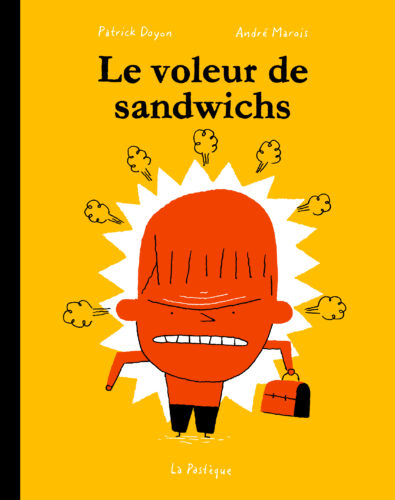


By:
Betsy Bird,
on 1/7/2016
Blog:
A Fuse #8 Production
(
Login to Add to MyJacketFlap)
JacketFlap tags:
Reviews,
Best Books,
funny picture books,
Sebastian Meschenmoser,
German children's books,
translated picture books,
NorthSouth Books,
German imports,
Best Books of 2016,
2016 imports,
2016 picture books,
2016 reviews,
Add a tag
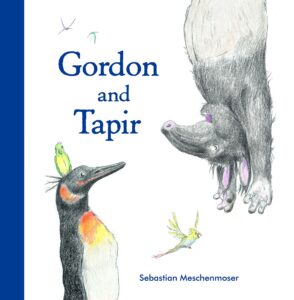 Gordon and Tapir
Gordon and Tapir
By Sebastian Meschenmoser
North/South Books
$18.95
ISBN: 9780735842199
Ages 3-6
On shelves April 1, 2016
There is a perception here in America about the Germans. It is a firm belief that, as a nation, they are devoid of a sense of humor. Americans love to bring this up. I’m not sure what they’re trying to prove necessarily when they say it, but the idea has been repeated so often that few would bother to contest it. Can you name any German stand-up comics? How about funny imported German films? What about funny German picture books? AH HA! There I’ve got you. Because while I cannot pull out of a hat any comics or movies, what I can do is show you without a sliver of a doubt that thanks to picture books like those of Sebastian Meschenmoser, we have absolute proof that Germans have a distinct and ribald sense of humor. With the release of his latest book in the States, Gordon and Tapir, Meschenmoser plumbs the Odd Couple concept with some distinctive twists of his very own. This is some primo German goofball stuff.
The book opens wordlessly. A penguin goes to his restroom with a newspaper. He reaches for the toilet paper. But what is this? Someone’s used it all up. And not just anyone. The penguin, who goes by the name of Gordon, stamps down the hall to his roommate Tapir’s room. Inside he finds the animal reclining in a toilet paper constructed hammock, an elaborate fruit cup in hand and a headdress that would wow Carmen Miranda on his noggin. Immediately Gordon launches into a litany of transgressions Tapir has engaged in. The floor’s sticky with fruit, the dishes are never done, and why exactly has there been a hippo living in the bathtub for the past few days? Tapir isn’t taking this lying down. He has his own complaints, like why does EVERYTHING have to be so neat and tidy? Why does the garbage have to stink of fish all the time? And why can’t Tapir join Gordon’s all-penguin club? Eventually, Gordon moves out and once Tapir discovers this he gives the bird a call. Turns out, it is a fantastic solution. Now Tapir can be dirty, Gordon can be neat, but they can visit each other and be friends again far better than if they lived together. Happy endings for all.
I’ve always carried the torch for Meschenmoser’s art. From his sleepless animals in Waiting for Winter to his previous penguin dip into surrealism in Learning to Fly the man has a strange kinship with the furry and feathery. So much of the character development in these tales comes from their body language. For example, there’s a spread in this book where Gordon lies in bed on his back staring at the ceiling at 3 a.m. while Tapir does much the same thing, albeit blearily, in his own room. This is followed by a silent film of sorts where Gordon finds a new place to stay in the paper and takes off as Tapir hears the door open and looks up with just the saddest expression in his eyes. Any picture book that dares to go silent for an extended amount of time in the center of the story is being gutsy. It’s not easy to pull off, and Meschenmoser ups the ante (as it were) by rendering everything during those wee hours of the morning in black and white graphite sketches.
 Then there are the little visual details and gags. The humor is sublime here. Meschenmoser is just as comfortable with silent gags (remember, this is coming from the man who made Charlie Chaplin references in the images of Mr. Squirrel and the Moon) as he is with words. Some of the jokes are there for the parents doing the reading. Did you notice the tapir in a bathing suit that bedecks the inside bathroom door? Or the fact that when Gordon stomps from the bathroom to Tapir’s room the wallpaper goes from a pristine fish pattern to paper that’s torn and peeling in large chunks? Did you see that the little cactus that Tapir gives to Gordon as a housewarming present is sitting on his dresser earlier in the book? And did you know that every single one of Gordon’s penguin friends is based on a famous author? I’ve good money riding on the fact that one of them resembles Sigmund Freud. I loved that Gordon has a goldfish swimming in his party drink (a tasty treat for later?). And so tiny you’d probably miss them but worth it every time I notice them is this: mongooses in teeny tiny colorful party hats. Life is sweeter because they are there.
Then there are the little visual details and gags. The humor is sublime here. Meschenmoser is just as comfortable with silent gags (remember, this is coming from the man who made Charlie Chaplin references in the images of Mr. Squirrel and the Moon) as he is with words. Some of the jokes are there for the parents doing the reading. Did you notice the tapir in a bathing suit that bedecks the inside bathroom door? Or the fact that when Gordon stomps from the bathroom to Tapir’s room the wallpaper goes from a pristine fish pattern to paper that’s torn and peeling in large chunks? Did you see that the little cactus that Tapir gives to Gordon as a housewarming present is sitting on his dresser earlier in the book? And did you know that every single one of Gordon’s penguin friends is based on a famous author? I’ve good money riding on the fact that one of them resembles Sigmund Freud. I loved that Gordon has a goldfish swimming in his party drink (a tasty treat for later?). And so tiny you’d probably miss them but worth it every time I notice them is this: mongooses in teeny tiny colorful party hats. Life is sweeter because they are there.
But for all that, the real reason I loved this book as much as I did was that the lesson I took away from it wasn’t American in the slightest. Imagine if a Yank tried writing the same book. Gordon and Tapir would have their differences. They’d have their fight. They’d both spend a sleepless night. Then the next morning Gordon would make a concession, Tapir would make a concession, and they’d work out their differences. And there is nothing wrong with a book about meeting someone halfway. Yet what I loved so much about this book was the fact that it eschewed every rote picture book plot I’d come to expect and went in an entirely new direction. Because honestly, let’s face it, sometimes friends are NOT meant to live together. Couples grow apart, people change, and there are times when you are much closer to someone if they don’t share the same space that you do 24/7. Meschenmoser makes it crystal clear that Gordon and Tapir’s friendship is stronger when Gordon leaves. Now I’m sure some folks will read this as a “stick with your own kind” narrative (after all, tapirs and penguins don’t even occupy the same temperate zones) but I’d argue that their friendship belies that. It isn’t that they don’t vastly enjoy each other’s company. They just need their own personal space at the end of the day, and that is absolutely 100% a-okay.
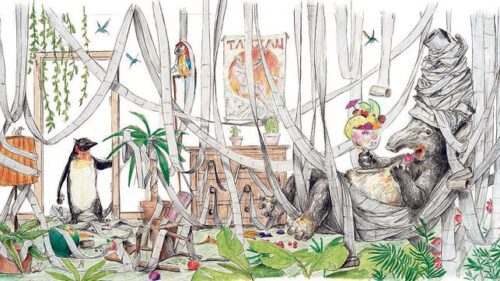 As crazy as it sounds, this actually wouldn’t be the worst picture book to hand to a small child with parents going through a divorce. I think it’s pretty clear from the book that sometimes you have nothing in common with the person you’re living with and that it’s best for all parties if a split is made. I don’t think the book was written with that intention in mind, and that is probably why it would work particularly well. There isn’t any didacticism to plow through. Just good storytelling
As crazy as it sounds, this actually wouldn’t be the worst picture book to hand to a small child with parents going through a divorce. I think it’s pretty clear from the book that sometimes you have nothing in common with the person you’re living with and that it’s best for all parties if a split is made. I don’t think the book was written with that intention in mind, and that is probably why it would work particularly well. There isn’t any didacticism to plow through. Just good storytelling
There’s a long history of funny German children’s literature that leads directly to Mr. Meschenmoser. Remember that this is the country where Der Struwwelpeter came to light (though its humor is a bit of an acquired taste). And alongside fellow contemporary funny German picture book artists like Torben Kuhlmann and Ole Konnecke he’s in good standing. With any luck we’ll be seeing more of their books coming to U.S. shores in the coming years. So who knows? Maybe if we get enough Gordon and Tapir types of books the humorless perception of the German people will undergo a change. At the very least, we’ll get some magnificent stories out of the deal. This one’s a keeper.
On shelves April 1st.
Source: Galley sent from publisher for review.
Like This? Then Try:

 I know it gets confusing but this list is a bit different from the Calde-not list from a couple days ago. The reason is simple. While the Calde-not list looks primarily at books with illustrations so distinguished they could easily win major illustration awards if given half a chance, this is list is more for those books that may not blow you away on a first glance, but that make our publishing landscape richer for their very existence. I was inordinately pleased after I read each and every one of these books. They’re a little peculiar, distinctly different from what you’ll find in the American market, and altogether remarkable.
I know it gets confusing but this list is a bit different from the Calde-not list from a couple days ago. The reason is simple. While the Calde-not list looks primarily at books with illustrations so distinguished they could easily win major illustration awards if given half a chance, this is list is more for those books that may not blow you away on a first glance, but that make our publishing landscape richer for their very existence. I was inordinately pleased after I read each and every one of these books. They’re a little peculiar, distinctly different from what you’ll find in the American market, and altogether remarkable.


























Read this aloud to my 4th graders last year with great success. I did so because one child had read Five Children and It and pestered me to read this one aloud so I did. But none of the others had nor did they have any desire to after I read this one. This year one of my fourth graders read it and loved it. She did take Five Children and It to read afterwards, but seems to have lost steam with it. So I think this works just fine without familiarity with the earlier books. I suggest giving it to those who like The War That Saved My Life.
Just read this (I’d loved the earlier books as a child). I thought the author did a terrific job, balancing the lightness and fantasy of the story with the waste and bleakness of war–handling it in a deft way for the age group. Definitely worth reading.